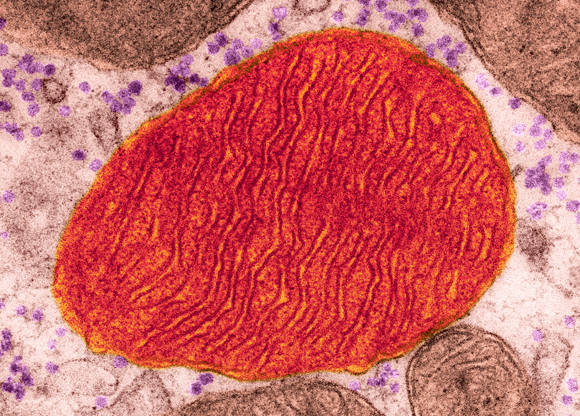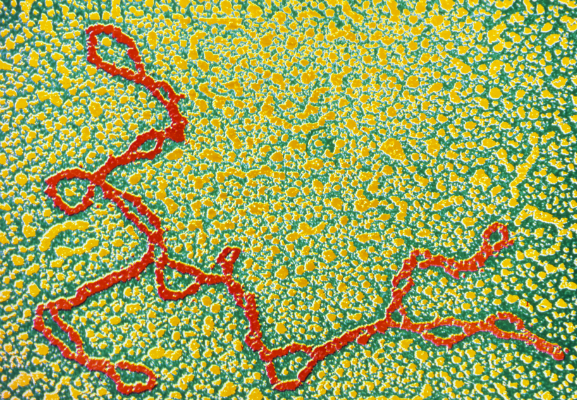What type of DNA is found in hair? What is mitochondrial DNA? Can it be used to identify criminals? Q&A
How many types of DNA do we have, and why?
When we talk about our genes – those inherited from our parents, those which determine our eye or hair color and numerous other traits, and those which we refer to when we say that something is "in our genes" – we are talking about the genetic material in our cells' nuclei. Nuclear DNA is packed into 23 pairs of chromosomes; one chromosome in every pair was inherited from each parent. Most of the genetic research is conducted on this type of DNA: when headlines announced that the human genome has been deciphered, they referred to the DNA inside the nucleus.
But the nucleus is not the only location in our cells in which DNA can be found. Almost all of our cells contain tiny organelles called mitochondria, which fulfill the essential role of breaking down sugar for energy production. These structures are found in cells of all animals, plants, fungi, and nucleated unicellular organisms. Without mitochondria, we would not be able to produce energy efficiently, and none of the complex creatures would have been able to exist as we know them.
Mitochondria were once independent organisms, similar to bacteria, which inhabited the ancient oceans. Like all organisms, they contained genetic material, DNA, with the instructions for producing the proteins they need. A long time ago, probably over two billion years ago, mitochondria merged with another, larger, unicellular organism and formed a symbiotic relationship: they produced energy and the host cell provided food and protection. Over many generations, this cooperative relationship developed into the intracellular structures we are familiar with today.
Over the years, mitochondria have adapted themselves to life inside other cells and lost many of the proteins that sustained their independent existence. But not all of them, and this is why they still contain DNA with instructions for producing their proteins. Some of that DNA has moved to the nucleus, where the rest of our genes reside, but some of it can still be found in the mitochondrion itself: this is the mitochondrial DNA.
Comprised of one small chromosome and less than 17 thousand base pairs, mitochondrial DNA is very short in comparison with nuclear DNA, which includes three billion bases on 23 chromosome pairs. Nevertheless, every cell contains a single nucleus – but numerous mitochondria: in some cells, there are thousands of these small structures, and thus such cells contain thousands of copies of mitochondrial DNA.
Another difference between the two DNA types is that we inherit mitochondrial DNA only from our mothers. Sperm cells contain mitochondria, but they are located in the tail of the cell, which remains on the outside as it fuses with the egg. Sperm cell mitochondria that still manage to make it inside are destroyed during fertilization.
Are our traits influenced by mitochondrial DNA? Typically, we will not witness its effect, but in some cases mitochondrial DNA contains harmful mutations that do affect mitochondrial function – and may lead to serious diseases. These illnesses can only be inherited from the mother.

What kind of DNA can be produced from a hair?
Our hair grows outwards from the root. Found under the surface of the skin, the root contains living, nucleated cells; nuclear DNA may thus be produced from root hairs quite easily. Hair grows when cells at the root divide and reproduce, and are then pushed up along the hair. During this process, they change, fill with the protein keratin, and eventually, their nucleus and the genetic material within it are degraded and the cell dies. So while hairs are built from the keratin made by the cells, very little remains of the cells themselves.
In some people, traces of cell nuclei may be found in the hair itself, not only in its root, but this is quite rare. In most cases, nuclear DNA is broken down into its building blocks, and if a hair lacks a root, it will be impossible to extract a useful DNA sample.
In contrast, not all mitochondria from the cells break down during this process. The cell contains two copies of nuclear DNA, but hundreds of copies of mitochondrial DNA, some of which remain intact even when the cell dies. Therefore, such a DNA sample may be extracted from a hair even if its root is not available.

Can a person be identified by their mitochondrial DNA?
Nuclear DNA is inherited from both parents, and as sperm cells and eggs form, they undergo another step of DNA mixing called recombination: each chromosome exchanges DNA segments with its pair. For instance, a paternal chromosome number 2 may acquire a part of the maternal chromosome number 2. As a result, except for the X-Y chromosome pair, in which the chromosomes are highly dissimilar and therefore recombination between them is limited, all chromosomes change from generation to generation. We may have received half of our chromosomes from our mother, but none of them is exactly similar to those she had inherited from her mother, since they have all exchanged DNA segments with her paternal chromosomes.
This process leads to a high level of variation in nuclear DNA. Certain regions of the genome, especially those that are responsible for making important proteins, have the exact same genetic sequence in most people. But there are many other regions in which variation is especially high. Sexual reproduction and recombination make our genomes different, even from that of our family members. Comparing a sufficient number of regions with high variation throughout the genome enables us to identify, with a high level of certainty, which person is the source of a nuclear DNA sample.
Mitochondrial DNA is only inherited from our mothers and does not undergo recombination. This means that our mitochondrial DNA is identical to that of our siblings, our mother and her sisters, and her sisters' children, as well as to that of our mother's mother and her siblings, etc. This is limited by the fact that at some point, a random mutation will occur and would be passed on to the next generation. This is why mitochondrial DNA is used when we want to examine an individual's maternal dynasty.
What about identification? Mitochondrial DNA, too, contains variation, stemming from the mutations it undergoes. Examining regions of high variation along the chromosome enables us to establish that a certain person, who has dissimilar sequences in those regions, is not the source of the sample – but it is much more difficult to determine who it does belong to. Even if we examine all possible regions (of which there are very few along the mitochondrion’s short chromosome), we are still looking at a large number of people that may share those sequences, and the sample may belong to any one of them.
In many cases it is difficult even to determine how many people share a specific sequence, so we cannot conclude what are the chances that it matches a random individual with no relation to it. According to the best estimates, the chances of this may be as high as 1:1000 or more.

Can suspects be convicted based on mitochondrial DNA?
Nevertheless, investigators use mitochondrial DNA testing to identify bodies or bodily remains when there is another, non-genetic, basis for suspecting the deceased’s identity. A mitochondrial DNA match may serve as supportive evidence for identification purposes. For instance, the bones of King Richard III were identified by testing the mitochondrial DNA of his living maternal relatives.
What about courtroom evidence? In the U.S., mitochondrial DNA tests have been presented in rape and murder cases since the 1990s. Over the years, they have led to several acquittals of previously convicted individuals. The first of these was William Gregory, convicted for rape and attempted rape in 1993. He was released in 2000, after the hairs found in the victim's pantyhose were found to contain mitochondrial DNA that did not match his.
Mitochondrial DNA evidence was also used in convictions, but experts warn that it can only serve as supportive evidence, another “piece of the puzzle” alongside other evidence. On their own, mitochondrial DNA tests may only rule out a link between the sample and a specific person, but not prove such a link.
Translated by Elee Shimshoni
